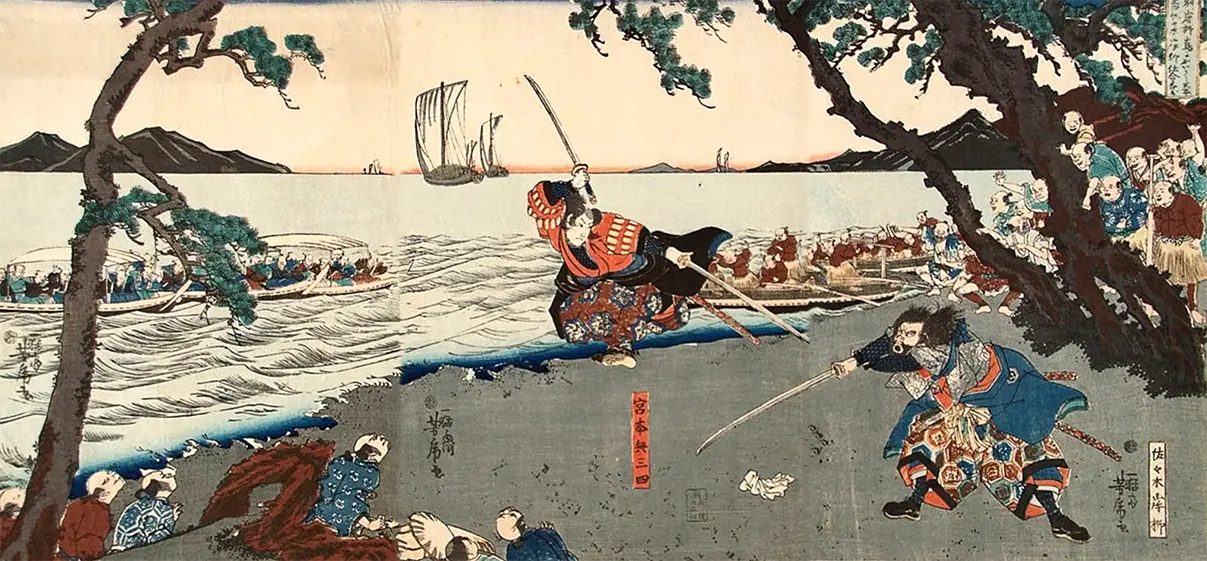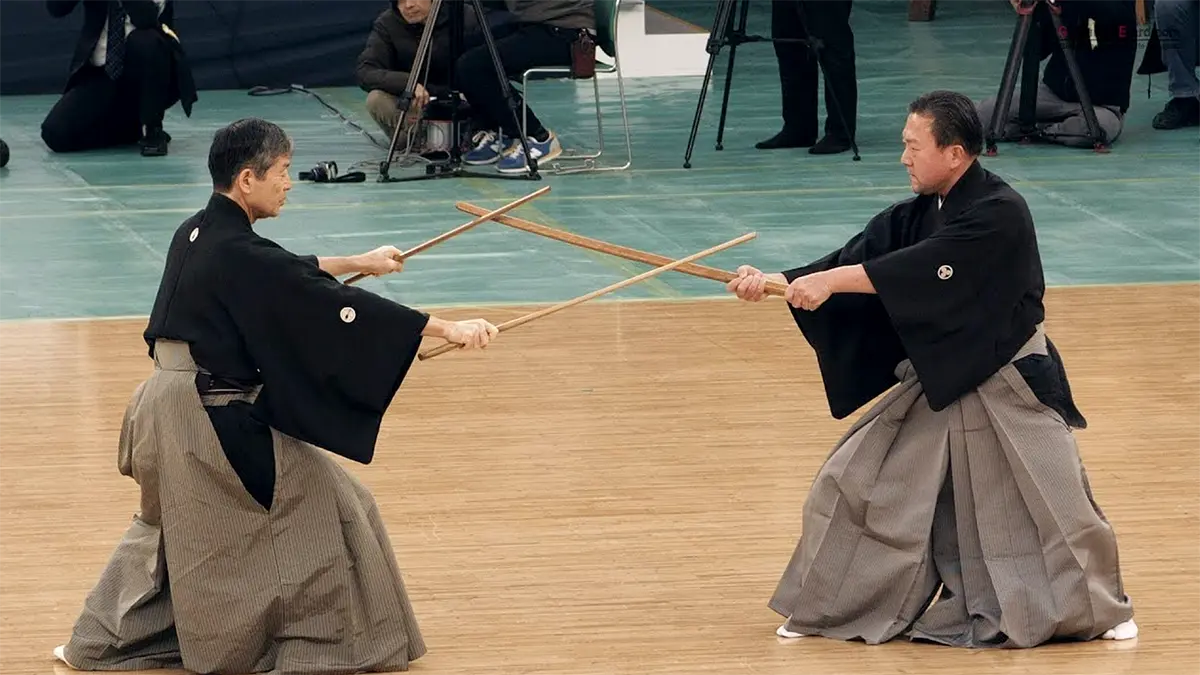
Musashi Miyamoto
The Most Famous Duel of Miyamoto Musashi Took place in 1612 against another great Japanese swordsman, Sasaki Kojiro, at 8 a.m. on Ganryujima, a small island located between Honshu and Kyushu.
Renowned samurai and expert in katana swordsmanship (shinken), Miyamoto Musashi is considered one of Japan’s greatest Kenshi (grand master of kenjutsu, the art of the sword). His exploits have inspired countless stories and legends.
He is the archetype of the medieval Japanese hero.
Born in 1584 in the province of Harima, he was the second son of Munisai Shinmen, himself an expert in the katana, who left him orphaned at the age of 7 (killed in a duel).
Raised by his uncle in a monastery, Musashi used this forced stay to train with the katana and won his first duel at the age of 13 against Arima Yoshibe.
At 17, he fought under the banner of Toyotomi Hideyoshi in the Battle of Sekigahara in 1600, during which he was seriously wounded.
From 1604, he was found in Kyoto, where he challenged and defeated Yoshioka Seijuro, a prominent katana master, along with many members of his clan.
Undefeated in over 60 duels, he faced for the last time the famous swordsman Sasaki Kojiro of the Mori clan, renowned for his long sword (O-dachi).
Killing his opponent with a simple wooden oar according to legend, Musashi never fought again.
From the 1630s, he devoted himself entirely to the study of the Way (Dō), while also practicing calligraphy and painting, arts in which he excelled.
He became a Kensei during his lifetime (a “saint of the sword”).
In 1637, he entered the service of his former adversaries, the Tokugawa, and fought for them against the Christian rebels of Shimabara.
He was later placed in command of a reserve corps by Ogasawara, lord of Kokura, during the siege of Hara Castle in 1638.
At that time, he adopted two childrens : Iori and Mikinosuke.
The latter committed seppuku (ritual suicide) a few years later.
In 1640, he became an instructor to the powerful Hosokawa family of Kumamoto.
In 1643, he retired to the Reigendo cave (temple of Ungan-ji on Mount Iwato, east of Kumamoto).
It was there that he wrote several masterpieces, including in 1645 the Gorin no Sho (The Book of Five Rings), which has become a classic of literature concerning strategy and martial arts.
He died at the age of 62 and, according to his wishes, sat upright and clad in his armor.
Musashi Miyamoto contracted eczema at a very young age, which left large scars on his face that he kept throughout his life.
For this reason, he did not look like the other samurai of his time. As a result, he never shaved his head nor wore the traditional samurai topknot.
Miyamoto Musashi was a giant for his time. He measured nearly 1m84 (about 6 feet), while his fellow Japanese warriors averaged 1m53 (5 feet).
It is said that Musashi never took a bath in hot water. He would wash himself in the icy waters of mountain streams to strengthen his mental resilience.
The way of the sword
When Musashi returned to his village, he was not welcomed as a hero.
The elders of the village considered him uncontrollable, and he had to leave.
He eventually found himself held captive at the Hejime Castle, where he learned the way of the warriors.
After a long period of training, Musashi was offered an important position by a daimyo (lord of a region of varying size).
He politely refused, choosing instead to become a warrior seeking enlightenment (musha shugyō).
The Yoshioka Family
He then set off toward Kyoto, which was the capital at the time.
Wishing to test his combat skills, he challenged in 1604 one of the most renowned schools, that of the Yoshioka family, whose founder was reportedly a famous duelist.
The first to answer Musashi’s challenge was Seijiro, head of the Yoshioka family.
Seijiro was armed with a real blade, while Musashi wielded only a bokken (wooden sword).
The fight did not last long.
Seijiro lost his right arm in the duel and later died.
This caused Musashi to earn the hatred of the Yoshioka clan.
The second duel was against Denshichiro, Seijiro’s brother.
The fight was brief but violent.
Musashi crushed Denshichiro’s skull in the blink of an eye.
Furious at Musashi’s behavior, the Yoshioka clan provoked him a third time, sending Matashihiro, still a child, to face him in a duel.
But unlike his usual custom, Musashi arrived early for the confrontation.
He had time to witness the cowardice of the Yoshioka in action and finally attacked them.
Matashihiro was killed, and Musashi escaped from about 80 samurai who were lying in ambush, killing around a dozen members of the clan.
This was the famous Ichijoji battle. Musashi then resumed his journey, winning challenge after challenge, remaining undefeated in over 60 duels.
Muso Gonnosuke
History gives us different versions of the encounter between Musashi and Muso Gonnosuke.
Having met Musashi and being defeated by him the first time in 1605 in the Harima province at Akashi, Gonnosuke judged that his traditional 1m80 staff (bo) could not reach a sufficient speed against a katana.
He then retreated to Mount Honman (in Kyushu) and shortened the staff’s length to 1m30 after several mystical experiments.
He combined the handling of this new shorter staff (Jo) with techniques he already knew from the spear, the katana, and the naginata (polearm).
Legend says that when he faced Musashi for the second time, the shorter Jo, even when parried, allowed him to reach a weak point on the swordsman’s body, striking him in the solar plexus.
Gonnosuke managed to defeat Musashi without causing him serious harm. But this was considered Musashi’s only recorded defeat, attributed to a new Jo-jutsu technique.
Sasaki Kojiro
In April 1612, Musashi met the famous Sasaki Kojiro of the Mori clan, renowned for his famous long sword (O-dachi).
He faced him on the island of Mukojima, using either a simple wooden stick or an oar (depending on the version).
The duel took place on the beach.
A single strike to Kojiro’s head brought him down on the sand, defeated by the unusual reach of Musashi’s weapon.
There are many other versions of this duel, some claiming that Musashi lost, while others argue that Musashi was a coward, etc.
Musashi never followed the teachings of any particular kenjutsu school.
Likely benefiting first from his father’s talent, then from training at the monastery, he mainly acquired his combat techniques on his own. He later took on the status of musha-shugyō (the warrior’s quest — a way of learning martial arts by confronting different schools and masters to test and refine one’s technique).
Musashi experimented extensively and eventually created his own technical synthesis.
He created a two-sword fighting style (katana and wakizashi) called nito-ryū (also called niten-ryū), which he notably used during the Ichijoji battle.
Although the school disappeared after his death, two-sword kata (training forms) are still transmitted today through kenjutsu in later lineages.
The Hyōhō Niten Ichi-ryū school, however, claims to preserve and teach Musashi’s original techniques.

Hyōhō Niten Ichi-ryū, Miyamoto Musashi's Two-Sword School



